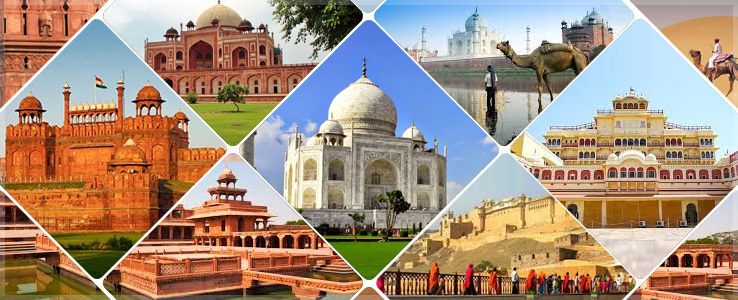Understanding the Golden Triangle Circuit
The Golden Triangle of India forms a well-traveled route connecting three iconic cities—Delhi, Agra, and Jaipur. Each city lies roughly 200–250 kilometers apart, creating a triangular shape on the map, hence the name. This circuit offers a concentrated introduction to India’s deep-rooted culture, Mughal and Rajput history, UNESCO World Heritage Sites, and diverse architecture.
Traveling through this triangle gives visitors a chance to explore contrasts—Delhi’s bustling modernity, Agra’s Mughal elegance, and Jaipur’s regal charm. The route is ideal for a one-week trip, often extended to include nearby attractions like Ranthambore, Varanasi, or Udaipur.
Ideal Duration and Travel Flow
A standard Golden Triangle itinerary spans 6 to 7 days. This duration allows travelers to absorb the heritage and nuances of each city without being rushed. Here’s a commonly followed sequence:
Day 1–2: Delhi – Explore Old and New Delhi including India Gate, Qutub Minar, Jama Masjid, Humayun’s Tomb, and bustling markets like Chandni Chowk.
Day 3: Agra – Visit the Taj Mahal at sunrise, followed by Agra Fort and the Itimad-ud-Daulah (Baby Taj).
Day 4–5: Jaipur – Drive to Jaipur via Fatehpur Sikri, then visit Amber Fort, City Palace, Jantar Mantar, and Hawa Mahal.
Return to Delhi on Day 6 or extend to nearby destinations. For those short on time, a Same Day Guided Tajmahal Tour with Agra Fort and Baby Taj can efficiently cover Agra’s key highlights from Delhi in just one day.
Best Time to Visit
The ideal time to undertake the Golden Triangle India Tour is from October to March, when the weather is relatively cool and pleasant. Summer months (April to June) can be quite hot, especially in Jaipur and Agra. Monsoon season (July to September) offers lush greenery but may hinder sightseeing with unexpected showers.
Winter months allow for comfortable walking tours, cultural festivals, and scenic photography, especially during foggy early mornings near the Taj Mahal.
Transportation and Connectivity
Travel between Delhi, Agra, and Jaipur is well-supported through multiple transport modes:
By Road: The Yamuna Expressway connects Delhi and Agra, and NH21 links Agra to Jaipur. Comfortable taxis and private cars are preferred for flexibility.
By Train: High-speed and luxury trains operate regularly among the three cities.
By Air: Though Jaipur and Delhi are well-connected by flights, air travel isn’t common on this route due to the short distances.
Travelers who wish to witness wildlife along the way can add a detour to Ranthambore National Park. Booking a Ranthambore Gypsy/Jeep Safari allows you to experience India’s tiger territory without veering far from the Golden Triangle route.
Cultural Highlights and Experiences
The Golden Triangle doesn’t just showcase architecture; it’s also a melting pot of cultural experiences. In Delhi, travelers can explore centuries-old bazaars, Sufi shrines, and colonial-era buildings. Agra is steeped in Mughal legacy, with intricate inlay marble work, cuisine, and Islamic art.
Jaipur brings color and craftsmanship into focus—with gemstone markets, traditional textile production, puppet shows, and folk music. Don't miss out on Rajasthani thalis and local handicrafts in each city.
Many comprehensive itineraries such as the golden triangle india tour package offer an organized flow of these experiences under expert guidance.
Accommodation Options and Booking Tips
Each city along the route has diverse lodging options—from heritage hotels and modern resorts to budget guesthouses and homestays. Booking in advance is essential during peak seasons (October–March), especially around festivals like Diwali, Holi, and Republic Day.
Jaipur, in particular, offers heritage stays in old havelis and palaces converted into boutique hotels. In Agra, several hotels offer Taj-facing rooms ideal for sunrise photography.
To combine cultural richness with architectural beauty across the state, some travelers also explore wider Rajasthan Tour Packages, which include Jodhpur, Udaipur, and Jaisalmer beyond the Triangle.
Travel Tips for a Smooth Journey
Local Guides: Hiring certified guides ensures deeper insight into history, legends, and lesser-known facts.
Dress Modestly: Especially in temples and religious sites, modest attire is appreciated.
Safety: The Golden Triangle is tourist-friendly, but general safety tips apply—avoid isolated areas at night, use authorized transport, and keep valuables secure.
Currency & SIM Cards: Currency exchange is available at airports and major hotels. Local SIM cards with internet packages are helpful for navigation and bookings.
Photography: While photography is allowed in most places, some interiors like inside temples or the Taj Mahal’s main mausoleum restrict flash usage.
Suggested Itinerary Add-ons
If you have a few more days, consider the following additions to your Golden Triangle journey:
Ranthambore – Ideal for wildlife lovers and conveniently located between Jaipur and Agra.
Udaipur – Known for its lakes and palaces, a romantic extension to your trip.
Varanasi – For a spiritual dimension, connect via flight or overnight train from Delhi.
Mandawa – A detour from Jaipur known for fresco-filled havelis and lesser-crowded experiences.
These extensions make the core triangle even richer in diversity and experience, especially for those pursuing photography, heritage studies, or cultural research.
